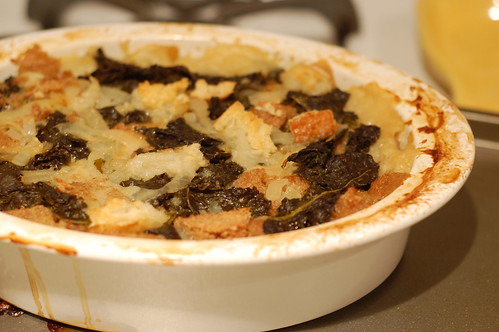
I don't think I've ever met a recipe using stale bread that I didn't like it. Think about it- every culture has a way of using up the perennial problem of bread past its prime- bread pudding, french toast, croutons, in Italy its strata, panzanella, and ribollita, in Spain it's gazpacho, in the Middle East pita bread turns into fetteh and fattoush, in Mexico tortillas become chips and tostados... you better stop me now before I start making spreadsheets.

But what I really like are that these are all homely in their goodness. A friend of mine went on a trip to Italy and he described, after several days of eating in Puglia's finest restaurants, telling his companion, "I just want to eat peasant food." A simple checkered tablecloth, a big bowl, a glass of house wine poured by weathered hands, I knew exactly what he meant.
A panade, a dish from Southwestern France that involves bread, onions, vegetables and cheese, layered and baked in a slow oven, is just this kind of thing. I first read about panade in a book of culinary history that compared panade to the Arabic dish fetteh- since both involve layering bread and dairy. The two dishes are completely different, but anything that can be compared to fetteh is in my mind certainly worth investigating. My first panade was reveletory- how could something so simple be so good, it's like the casserole your mother never made for you. Unless you're from Southern France, in which case I have a lot more reasons to be jealous of you. The bread softens so it becomes almost souffle-like, barely starch at all but pillows of puffy goodness infused with cheese flavor. If something can be homely and shocking at once, this is it.
There are a lot of other reasons I love panade- it doesn't use eggs, which I never seem to have on hand, and it's an endless blank canvas for experimentation. Use butternut squash, leeks, or tomatoes for the vegetable, or try blue cheese or rye bread, or infuse the broth with a variety of aromaics, the options are endless. But mainly I love panade for the simple economy of it, the pleasure of turning leftovers into something wonderful.
 Kale and Gruyere Panade
Kale and Gruyere PanadeRecipes for panade range from simple to complex versions where you have to fry the bread and make complicated sauces. This is one of the simplest versions, which I think is the heart of the dish and leaves open a wide range for experimentation. Some people suggest slicing day-old panade and pan frying it, but I think leftover panade is just as good as is.
olive oil
3 medium-sized onions, sliced
1 lb kale or swiss chard, tough ribs removed and torn into pieces
10 oz stale artisan-type bread, torn into pieces (about 3 cups, loosely packed)
about 2 cups grated Gruyere cheese, or a mixture of Gruyere, Parmggiano Reggiano, or hard sheeps milk cheese
2 cups good-quality light stock or broth plus 2 cups water
1. Heat a glug of olive oil in a large, wide, deep saucepan or dutch oven. Add the onions, stirring to coat, and a pinch of salt. Cook the onions over medium heat, stirring fairly frequently, until the onions are deep-honey in color, it should take at least 25 minutes. Set aside onions.
2. Wash the kale or chard and leave the water clinging to it. In a saucepan (you can reuse the same from the onions if you'd like), place the greens and cook over medium-high heat until they are wilted and soft, about 4 minutes for chrd and slightly longer for kale. Set aside.
3. In a bowl, toss the bread with about 2-3 tablespoons of olive oil and a few pinches of salt.
4. Preheat oven to 325 F. Bring the stock/water mixture to a simmer. Layer the panade: place a layer of onions in the bottom of a casserole dish. Scatter with bread pieces, then strew some greens over top, and sprinkle with cheese. Repeat. You want at least 2-3 layers of each component, and make sure a little bit of everything (greens, onions, bread, cheese) is peaking out the top. Do not fill your casserole more than 3/4 full or it may overflow. Pour the stock into the casserole dish, it should almost fill up to the sides of the ingredients.
5. Cover the top loosely with foil. Place in the oven on a baking sheet to catch drips. Bake 1 1/4 hours, or until thick and bubbly. Uncover and bake another 10-15 minutes, until the top is browned. Let cool slightly before serving. Makes good leftovers.






4 comments:
Now, that sounds really tasty! I must try it, with kale. I love kale! My husband doesn't care for the way I usually serve it, as a mash with potatoes, smoked farmer sausage, gravy and some yellow mustard. He might just like this.
This sounds delicious and I also like that it doesn't have any eggs, which makes it a bit lighter.
Your blog is super. So are your photographies. They make me hungry. I have spent a nice moment when seeing them. Thanks a lot.
i'm addicted to your blog. you should seriously consider writing a cookbook. i'm sure you could pitch the idea to a publisher easily with this page. plus, i want to buy it, so get busy.
Post a Comment